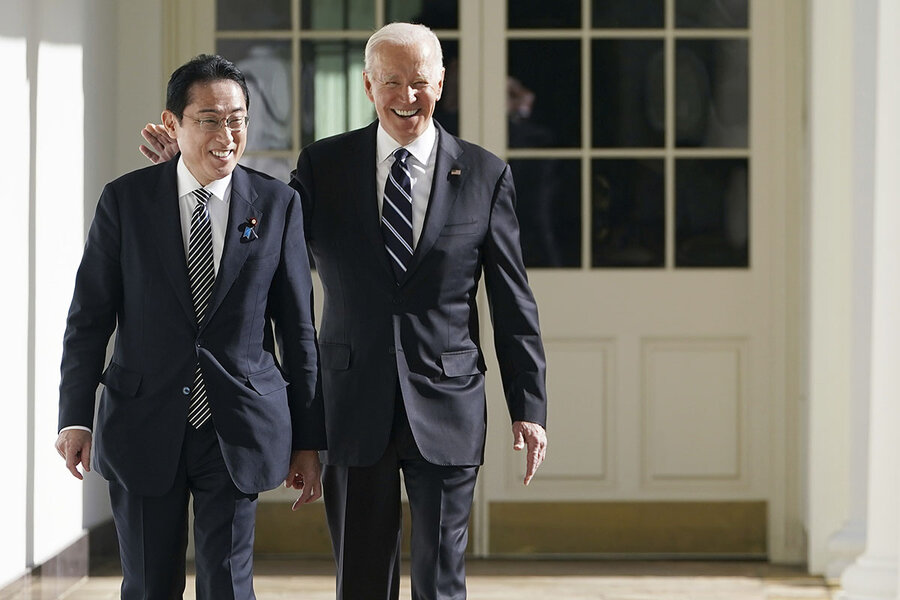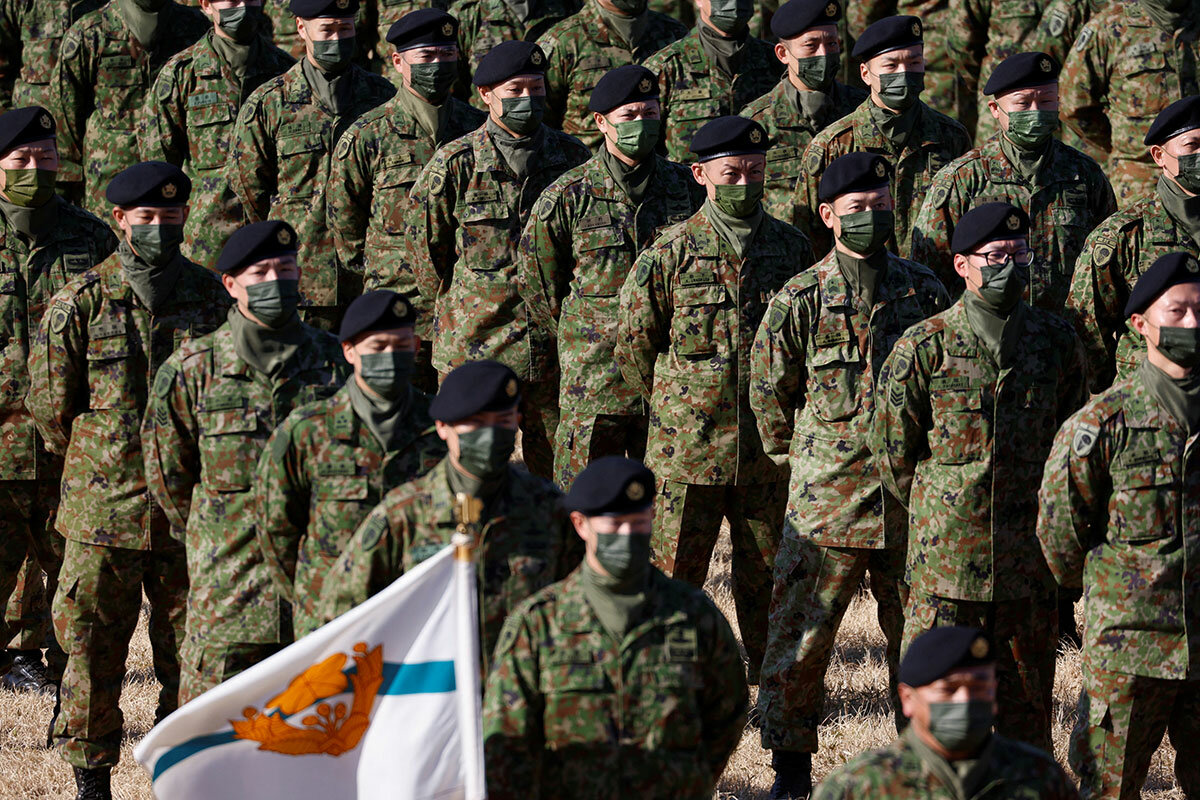Seeking stability – and responsibility – Japan builds up military
Loading...
President Joe Biden and Japanese Prime Minister Fumio Kishida met Friday to hail their countries’ robust new military cooperation and Japan’s unprecedented defense buildup – essential components of their shared vision for strengthening order and safeguarding peace in the Indo-Pacific.
The meeting underscored Japan’s status as the United States’ most critical ally in Asia, as the Biden administration applauds Tokyo’s willingness to shoulder greater responsibility for its own defense, and thereby play a bigger role in regional security.
In the Oval Office meeting, Mr. Biden said Japan and the U.S. have never been closer, pledged Washington’s full support for the alliance, and praised Japan’s “historic increase” in defense spending. Working together for peace and prosperity in the region is vital, Mr. Kishida said, stressing that “Japan and the United States are currently facing the most challenging and complex security environment in recent history.”
Why We Wrote This
A story focused onMaintaining peace in Asia requires cooperation. By building up its military, Japan is shouldering more security responsibility, and taking a step toward its vision of a stable region following a shared set of rules and norms.
Under bold new security initiatives announced this week, the U.S. and Japan will work together to protect Japanese satellites, bolster U.S. Marine forces in Japan, and fortify the country with hundreds of long-range American Tomahawk cruise missiles. The agreements come a month after Japan’s Cabinet approved an ambitious and transformational plan to shore up its military by doubling the share of GDP devoted to national security from 1% to 2% – spending an estimated $320 billion – over the next five years. The plan represents the most rapid expansion of Japan’s military might since World War II, marking a dramatic break with the strictly restrained, pacifist posture pursued by Japan since it established its Self-Defense Forces (SDF) in 1954.
“The main impetus [of Friday’s meeting] is to highlight the monumental nature of the step Japan has taken,” says Nicholas Szechenyi, deputy director for Asia at the Center for Strategic and International Studies (CSIS). “The White House wants to give a stamp of approval ... and to send a much broader signal about the strength of the U.S. alliance network.”
The defense push is designed primarily to deter China’s growing military assertiveness, but Japan’s larger vision is to build a unifying consensus for Asia, experts say.
“Japan’s ultimate objective in the Indo-Pacific is not to isolate, contain, or weaken China,” says Mr. Szechenyi. “More broadly, Japan’s objective is to develop an architecture in Asia based on rules and norms that ultimately China adopts.”
Stronger military capabilities could allow Japan to eventually enjoy better ties with China, he adds.
Japan’s top priority today is to work with the U.S., Australia, and other Indo-Pacific countries to counter China’s coercion and uphold the rules-based order in Asia, says Sheila Smith, senior fellow for Asia-Pacific Studies at the Council on Foreign Relations. “Japanese see the future better served in aligning in a coalition with like-minded partners,” she says.
Responding to increasing risks
Longstanding tensions surrounding China’s military buildup and presence in the East China Sea and North Korea’s advancing missile technology – coupled with concerns over Russia’s invasion of Ukraine – combined to push Tokyo to adopt the sweeping plans to expand its defense capabilities.
Japan’s national security strategy, unveiled last month, says China poses “the greatest strategic challenge” ever to peace and stability in Japan. China now has hundreds of missiles capable of hitting the island, according to the U.S. Department of Defense. Last August during major exercises around Taiwan, China fired five missiles into waters that are part of Japan’s exclusive economic zone, highlighting the risks for Japan of a Taiwan Strait conflict.
North Korea in October launched a ballistic missile that flew over Japan – the first in five years. And Russia has increased its military exercises and activity near Japan, including in joint exercises with China.
The shock to the international order of Russia’s invasion of Ukraine was a key factor in convincing Japan’s leaders and the public alike that the country must assume greater responsibility to safeguard its territory.
“Ukraine today may be East Asia tomorrow,” Prime Minister Kishida warned last summer.
The Russian invasion drove home to Japanese citizens not only the need for their country to acquire the ability to strike back at aggressors, but the urgency of doing so, experts say. Recent polls show that a majority of Japanese support the country’s plan to obtain a counterstrike capability with long-range missiles.
Before the Ukraine conflict, “many Japanese didn’t believe a major war could occur. … They have been living in a kind of euphoria,” says Tsuneo Watanabe, senior fellow at the Sasakawa Peace Foundation, an independent policy research organization in Tokyo. But the invasion “made it easy to say that Japan needs to be ready,” he says.
Cross-border buildup
Japan’s defense buildup is both ambitious and comprehensive, calling for a new integrated command to boost the ability of its three SDF forces to fight together, new investments in weapons technologies and innovation, and expanded cyber and space capabilities. Drawing on lessons from Ukraine, it stresses secure stockpiles of basic supplies such as ammunition and fuel.
Critically, Tokyo will also gain “counterstrike capability” from their planned purchase of American Tomahawk missiles, which have a range of 1,000 miles, allowing Japan to hit back deep within Asia. After decades of limiting the geographic reach of its military, “Japan will for the first time have missile … capabilities that allow it to reach out and touch its neighbors,” says Dr. Smith.
Despite the sense of urgency, the upgrades will take time, and heated debate is already underway domestically on how Japan will finance them. Mr. Kishida, a former foreign minister whose hometown is Hiroshima, is widely viewed as more diplomatic and dovish, and these qualities may have made it easier for him politically to push through the defense measures with less opposition, said Glen Fukushima, a senior fellow at the Center for American Progress, in an online talk Friday.
Tokyo is coordinating closely with Washington both on prioritizing and incorporating new defense capabilities, which by better protecting Japan could also free up U.S. forces. Meanwhile, other U.S. treaty allies in Asia such as South Korea, Australia, and the Philippines are also increasing defense cooperation.
For its part, Taiwan has welcomed Japan’s new defense initiatives as helpful for maintaining peace, while China has criticized the moves for provoking tension.
Growing concern over a Taiwan contingency is a major motivation behind Japan’s buildup, experts say. “If China planned to have a military operation to unify Taiwan, it’s impossible to avoid passing our territorial waters,” says Mr. Watanabe. “Japan wants … to deter such military action by China – that is the very first priority to maintain our security.”
Overall, Japan’s stepping up its defense capability and the broader strengthening of U.S. alliances in Asia reflects a heightened emphasis on shared principles as risks increase, says Dr. Smith, author of “Japan Rearmed: The Politics of Military Power.”
“When the tensions get high,” she says, “it provides opportunity for greater integration.”







